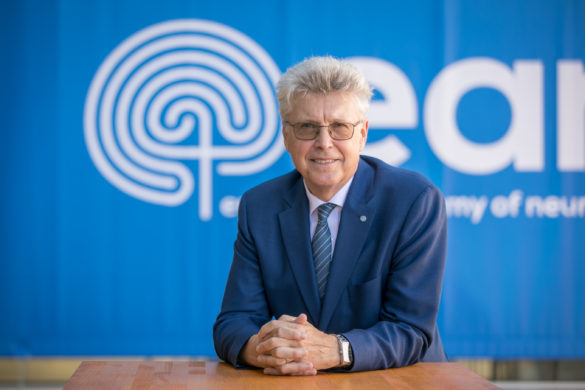Dear EAN-Members,
Dear colleagues and friends,
I hope that you all had a wonderful and relaxing summer, and that you have regained the energy needed for being successfully back to work after vacation. I always enjoy when the speed and intensity of daily activities reduce a little over summer, and I am sure that such times are also important for rethinking projects, developing new ideas, and enhancing our creativity.
Category
Featured Slider
-
-
Paper of the MonthEAN NewsFeatured Slider
Paper of the month: Improving neuropathy in hereditary transthyretin amyloidosis by targeting mRNA transcription
October 1, 2018For October 2018, we have selected two papers. The first is: Adams D, Gonzales-Duarte A, O’Riordan WD, et al. Patisiran, an RNAi therapeutic, for hereditary transthyretin amyloidosis.(APOLLO trial). NEJM 2018;179:11-21. The second is: Benson MD, M Waddington-Cruz, JL Berk, et al. Inotersen treatment for patients with hereditary transthyretin amyloidosis. (NEURO-TTR trial) NEJM 2018;179:22-31. Hereditary transthyretin amyloidosis is a rare autosomal dominant disorder in which mutations of the gene for transthyretin protein (TTR) induce systemic deposition of amyloid. -
by Prof. Dr. Serefnur Ozturk and Burak Tokdemir The Republic of Turkey is a country with an extraordinary history and the home of 80 million people. As one of the three countries in the world that span… Continue Reading
-
Executive PageEAN NewsFeatured Slider
Executive Page: American Dream 2018: Report of a Sleep Researcher
September 1, 2018In 2 weeks, my sabbatical period in the United States, which started in April 2018, will come to an end. The word sabbatical comes from “Sabbath,” which in the biblical Old Testament was described as, “In the seventh year the land shall have a Sabbath of complete rest …” Today in Academics, it is obviously not simply rest. For me it was a break after 23 years of an uninterrupted hospital and university activity, 17 of which as chair or vice-chair of large neurological departments. -
EAN NewsCountry of the MonthTop ArticlesFeatured Slider
Country of the month – Azerbaijan
September 1, 2018This is the Land of Fire and the Pearl of the Caucasus, a land where eastern colors combine magnificently with western progress. Azerbaijan is situated at the eastern side of the Transcaucasia on the shores of the Caspian Sea. The… Continue Reading -
Paper of the MonthEAN NewsFeatured Slider
Paper of the month: Apomorphine pump is effective for motor fluctuations in Parkinson’s disease
September 1, 2018For September 2018, we have selected: Katzenschlager R, Poewe W, Rascol O, et al. Apomorphine subcutaneous infusion in patients with Parkinson’s disease with persisten motor fluctuations (TOLEDO): a multicenter, double-blind, randomized, placebo-controlled trial. Lancet Neurol July 25, 2018. doi:10.1016/S1474-4422(18)30284-4. Subcutaneous infusion of apomorphine, a potent dopamine receptor agonist, is widely used in patients with Parkinson’s disease (PD) with motor fluctuations not optimally controlled with oral medication, but the previous evidence base to support this approach was weak, derived from open label studies. -
Executive PageEAN NewsFeatured Slider
Executive Page: Become a member of EAN, the ‘Home of Neurology’!
August 1, 2018The mission of EAN is ‘to promote excellence in neurology across Europe’. Therefore we need you, our colleagues, to become individual EAN members. Membership is not only for your own benefit, but also to accomplish our mission. As an individual member you can play an important role. By standing for election for the position as Delegate in the Assembly of Delegates you can become an influencer. -
Paper of the MonthEAN NewsFeatured Slider
Paper of the month: Impact of dopamine agonists dose and duration on impulse control disorders in Parkinson disease
August 1, 2018For August 2018, we have selected: Corvol JC, Artaud F, Cornier-Dequaire F, et al., for the DIGPD Study Group. Longitudinal analysis of impulse control disorders in Parkinson disease. Neurology 2018. doi:10.1212/WNL.0000000000005816. Impulse control disorders (ICDs) are frequent in Parkinson’s disease (PD) patients, and can have relevant consequences on social life. Whereas the association between treatment with dopamine agonists (DA) and the onset of ICDs is well known, there is controversy about the relationship with dose and duration of DA therapy. -
The roots of clinical neurology can be traced back to Germany. With his ”Lehrbuch der Nervenkrankheiten des Menschen“ (textbook of human nervous diseases) 1840, Moritz Heinrich Romberg (1795 – 1873) established the foundation of clinical neurology as we know it today. His work was the first and for decades the only systematic representation of neurological diseases in Europe and America, bringing him international fame and esteem.
-
Dear EAN Members, dear Colleagues, The 4th annual Congress of the European Academy of Neurology just held in Lisbon on June 16th - 19th was a spectacular event. More than 6,700 participants from 104 countries attended the meeting which covered the whole range of neurologic disorders in various formats, and offered altogether 42 scientific and 48 educational sessions. Besides several teaching courses and educational activities, the congress also comprised of 20 case-based workshops and interactive sessions, 7 hands-on courses, and 3 career development sessions.
-
Paper of the MonthEAN NewsFeatured Slider
Paper of the month: Waking up with a stroke: should we do thrombolysis?
July 1, 2018For July 2018, we have selected: Thomalla G, Simonsen CZ, Boutitie G, et al., for the WAKE-UP Investigators. MRI-guided thrombolysis for stroke with unknown time of onset. NEJM May 16, 2018. doi:10.1056/NEJMoa1804355. Thrombolysis is currently performed in patients with acute ischemic stroke within a window of 4.5 hours since the symptoms’ onset. In about one third of the patients, the exact time of stroke onset is unknown, like in patients who wake up from sleeping. -
oland is located in Central Europe between the Baltic Sea in the north, and the Sudetes and the Carpathian Mountains in the south, the majority of the area laying in the basin of the Vistula and Oder rivers. The country is inhabited by about 38 million people, and in terms of the area, which exceeds 300,000. km2, Poland is classified as 63rd on Earth. Its neighbours are: Germany, the Czech Republic, Slovakia, Ukraine, Belarus, Lithuania and Russia.
-
Portugal is a country with a 900-year history: many remnants of past colonization by Celtics, Romans, and Arabians are still present. Unquestionably, the greater contribution of Portugal to the humanity have been the overseas navigations around the world, namely the discovery of the maritime way to India, the discovery of Brazil and of several Atlantic islands.
-
The first team of board members is going to retire after the Lisbon congress and the incoming president, Franz Fazekas from Graz, Austria, will take over. He is an outstanding scientist in the field of Stroke and Multiple Sclerosis and has done a marvellous job for our Society during the past 4 years. His many qualities as an Austrian Cosmopolitan are a guarantee for an integrative presidency for the next years of further development of this young Society. It is my privilege to thank him and the outgoing board for an excellent collaboration.
-
Paper of the MonthEAN NewsFeatured Slider
Paper of the month: Long-term cohort studies confirm higher risk of cerebrovascular events in migraine patients
June 1, 2018For June 2018, we have selected: Mahmoud AN, Mentias A, Elgendy AY, et al. Migraine and the risk of cardiovascular events: a meta-analysis of 16 cohort studies including 152,407 subjects. BMJ Open 2018;8:e020498. doi:10.1136/bmjopen-2017-020498. Migraine is a worldwide common neurological disease. The link between cardiovascular and cerebrovascular events, especially in migraine with aura patients, has been shown by several studies. However, findings lack longitudinal and long-term follow-up.









